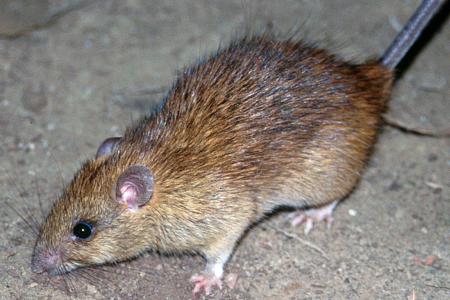1,000 more rat burrows detected in Singapore
Over 85 per cent found in housing estates by town councils
Some 1,000 more rat burrows were detected last year in public areas compared with 2014, said the National Environment Agency.
The total number of rat burrows last year: 43,000.
Some experts say that each burrow could have as many as 30 rats. This is an indication of a worsening rat problem, say pest controllers.
If left unchecked, a pair of male and female rats can be responsible for producing more than 1,300 rats in a year.
In response to queries, NEA also said that about 85 per cent of burrows were found in housing estates managed by town councils.
More than 80 per cent of these were found near bin chutes and bin centres.
Mr Hadi Hanafi, technical director of Innovative Pest Management, said his company has received a three-fold increase in rat-related calls in the last two years.
Mr Hadi, 34, called the increase in burrows "very significant".
"This shows that we have to be more well versed in tackling rat issues and to be vigilant. We not only have to catch the rats, but also go to the source to stop the rats from reproducing," he said.
He also revealed that his company has been getting an increasing number of calls about rat infestation in shopping malls.
"This is due to all the upgrading works that are happening. When one shopping mall gets upgraded, they will tear down the walls which 'disrupts' the rats. And the rats will move."
INFESTED
He said that while sewer or Norway rats are usually found in drains or HDB blocks, roof rats are the ones infesting the malls, and chewing up the ceilings. (See report above.)
Similarly, Dr Chan Hiang Hao, medical entomologist with pest control company Rentokil, said 10 per cent of the calls the company receives each day are rat-related.
On average, Rentokil receives 60 rat-related enquiries via telephone monthly.
Dr Chan told The New Paper: "Rats are one of the top five pests (in) enquiries monthly over the past two years."
According to Dr Chan, all it takes are food, shelter and water for rats to find a home.
"Burrows are commonly dug by the pregnant rats where there is food and water available.
"One cm is all a rodent needs to enter a building. Old buildings without consistent or regular maintenance are most at risk of allowing entry points for rodents, through cracks, gaps and crevices," he said.
In 2011, the NEA started an island-wide surveillance programme to monitor the rodent population.
Apart from detecting active rat burrows, potential causes of infestation like potential food sources are identified through this effort.
To further tackle this rat problem, a more coordinated approach among multiple stakeholders - including town councils and food shop operators - was piloted in Redhill Close, Bedok Central, Clementi Avenue 3 and Bangkit Road..
These stakeholders play their part through efforts like engaging their own pest control operators and coordinating their own rat control plans.
NEA has said that early results show a 15 to 70 per cent reduction in the number of burrows in each area.
From next month, NEA will also step up enforcement in Town Council areas.
In the meantime, the experts advise that food spills and waste be cleaned up.
Garbage bins covered and bulky items removed - so that the rodents don't have places to hide and breed in.
Bite marks on goods and food packaging, gnaw marks on electrical cables and urine on walls are all signs that rats are around.
Said Dr Chan: "It is important to build awareness and education around storage and waste management like food waste and cleanliness as well as proper disposal of bulky items."
Rat in viral video was caught
A video of a rat nestled among several loaves of bread at an NTUC Fairprice outlet in Hougang has been making its rounds online.
Uploaded early this week, Facebook user Sun Yuming's minute-long video showed the critter crawling over loaves of bread before scurrying away towards the aisle near the vegetables section.
Mr Sun also posted photos of bread loaves with packaging that had been gnawed at.
One of his posts has been shared over 1,600 times as of yesterday.
When contacted about the video and photos, a FairPrice spokesman told The New Paper that the rat had been caught on May 28, two days before the video was posted online.
The spokesman said the post about pests at the Kang Kar Mall branch had been made online in February and again on May 30.
"Our contracted pest control specialists have since stepped-up their efforts at the branch," the spokesman said.
The spokesman added that pest-control specialists hired by FairPrice visited the store four times in February and several more times in the months after that.
"In May alone, they have visited the store another five times.
"The store has also disposed of all products that may have been compromised by the pest and sanitised the area thoroughly."
The spokesman stressed that the supermarket chain's contracted pest control specialists "provide regular checks, identifying potential issues such as rodent entry points, and work with (their) maintenance teams to address these areas".
These specialists visit the stores at least once a month.
The spokesman added: "Our store operating procedures also include strict housekeeping guidelines that stores must adhere to."

One of the challenges the store faces is when pest occurrence stem from "external sources", he said.
"As such, we also ensure that the specialists are contracted to provide consultation and liaison services with external parties such as town councils and building management to collaboratively work out solutions.
"As a responsible retailer, food safety and hygiene is of paramount concern to FairPrice and we spare no effort in ensuring we maintain a clean environment while providing wholesome food to our customers."
Hougang residents that The New Paper spoke to say they have noticed rats in the area of Kang Kar Mall and Hougang Mall for a few months now.
Application consultant Cindy Quek, 56, said: "Since last month, I've always seen a group of rats outside FairPrice, near the loading and unloading bay outside the mall.
"Around 10pm, when walking past the area, my son could hear them rustling through the bushes. The bunch of rats, definitely more than 10 big ones, were running around in the dark."
Madam Quek has been living in a five-room flat in Block 462, across the street from Kang Kar Mall, for around 16 years, and it was only in the last month that she first noticed rats in Hougang.
Madam Quek's second-storey neighbour, in her early 30s, who wanted to be known only as Ms Jo-ann, has also spotted rats in the neighbourhood.
"Sometimes, I see a handful of skinny rats running around the shrubs in the whole cluster of malls, including Hougang and Kang Kar malls," she said.
"It's not disruptive, just not very hygienic. The rats have been more apparent and obvious since the start of this year."
Rats in Singapore
NORWAY RAT
Body length:
19cm to 22cm
Characteristics:
Large hind-quarters.
Tail is shorter than body.
ROOF RAT ( below )

Body length:
12cm to 22cm
Characteristics:
More slender body.
Tail longer than body.
RAT LIFE
Life span:
Maximum of four years for a Norway rat.
Reproduction:
Male rats reach sexual maturity at three months, while females reach sexual maturity at four.
Gestation period:
- 23 days
- Rats can give birth four to seven times a year, producing six to 12 babies each time.
- In a year, a female rat can give birth to up to 84 rats.
- In a year, one female rat can be responsible for more than 1,300 rats because its young will also reproduce.
RAT BURROWS
- Can go up to 6m in length and 90cm deep, with designated sleeping chambers, nurseries and even toilet areas.
- Can house up to 30 rats (including young) across two generations.
- One can be infected with various rat-transmitted diseases by breathing in dust or eating food that has been contaminated with rodent urine or dropping.
RAT CATCHING
Commonly used bait:
- Peanut butter, dried cuttlefish
Not easy because:
- Rats have excellent memories.
- They choose flight over fight when it comes to potential threats.
- Rats are fearful of new and unfamiliar objects, odours and tastes, so it takes time to lure them to traps.
Get The New Paper on your phone with the free TNP app. Download from the Apple App Store or Google Play Store now


